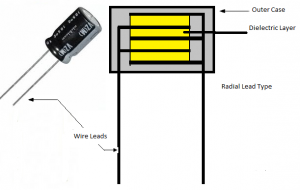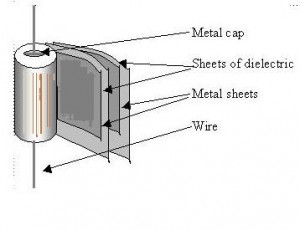Depending upon the type of dielectric material used in the capacitor there are variety of capacitors. The various types of capacitor are,
1) Film Capacitor
2) Ceramic Capacitors
3) Electrolytic Capacitors
4) Dielectric Capacitors
Film Capacitors
Film capacitors are used in the various kinds of electronic circuits. The various kinds of materials used in film capacitors are,
a) Polyester capacitors
b)Polystyrene capacitors
c)Polypropylene capacitors
d) Polycarbonate capacitors
e) Teflon capacitors.
The capacitance range of the film capacitors is lying between 5pF to 100uF. Further, this range of the capacitors is also depends upon the voltage rating of the capacitor. The film capacitors are also classified depending upon the shape and structure of the capacitor. The classification of film capacitor depending upon the structure is as follows,
a) Oval and Round
b) Epoxy type Rectangular
c) Epoxy type Round
d) Metal Sealed Rectangular
e) Metal Sealed Round
The film capacitor has thick dielectric films to avoid the defects and leakage in the films. Therefore the film capacitors are used for lower capacitance capacitors having larger sizes. In film capacitors, metal foils are used on the sidewalls of the dielectric material which has capacitive properties hence thinner dielectric films are used in this type of film capacitors. Therefore, these capacitors have higher capacitance values with small sizes.
Film Capacitors are also called as plastic capacitors because it uses polystyrene, polycarbonate and Teflon type of dielectric materials. Constructionwise plastic capacitors are same to paper capacitors. Only difference is plastic capacitors uses plastic films and the paper capacitors uses papers. The advantage of plastic capacitor over paper capacitor is that plastic capacitors operate efficiently under high temperature conditions and plastic capacitors also have lower tolerances, long life and high reliability.
The structures of film capacitors are shown below,
1) Radial Lead Type Film Capacitor

Fig. 1
2) Axial Lead Type Film Capacitor
Dielectric Capacitors
Dielectric Capacitors are the kind of variable capacitors having the capability of changing the capacitance value for tuning the transmitters, the receivers and the radios. These capacitors are used in tunned radio frequency transistor systems to set the band or the channel of the radio. These capacitors have the stator vanes and a set of movable plates the rotor vanes which move in between the metallic plates of the capacitor. The total capacitance of the capacitor depends upon the moving plates and the fixed plates. Figure bellow shows the dielectric capacitors,
Fig. 3
Ceramic Capacitors
Ceramic capacitors are also called as the disc capacitors. The reason for this is ceramic capacitors are made up by using the small ceramic disc. Normally for low capacitances in ceramic disc capacitances the size of disc is around 3-7 mm. Further, in disc capacitors large permittivity dielectric materials are used to have the larger capacitor value. Since the capacitance value of the capacitor s increased by the higher dielectric, the size of the disc type ceramic capacitor is low.
Fig. 4
The ceramic capacitors are mainly used as the decoupling capacitors. Further, as the disc capacitors are not having the polarities, the dic capacitors are used as the by pass capacitors The capacitance value of ceramic disc capacitors is in the range of picofarads to 1 microfarads. Further, the voltage rating of the ceramic disc capacitors is lower among all the types of capacitors. The coding system of the ceramic disc capacitors is given the color coding of the capacitors session.
Electrolytic Capacitors
Electrolytic capacitors have larger values of the capacitances. In this type of capacitor, thin metallic layer is used at the one side of the metallic plate and the electrolytic is used in the paste in between the other metallic plate. The electrolytic capacitor has polarities such as positive and negative polarities on the electrodes. The negative polarity is also called as the cathode. The dielectric material used in electrolytic capacitor is thin layer of oxide which is formed by electrochemical reactions with the electrolytic material paste. The oxide layer is thin due to which the electrolytic capacitors have large capacitance value. The physical size of the electrolytic capacitor is also low due to the thin distance between the metallic plates of the capacitors.
Fig. 5
Since the electrolytic capacitors are having both positive and negative polarities, the DC voltage provided through the battery should also be connected with the positive and negative polarities. Therefore positive terminal of bettry should be connected to the to the positive terminal of the capacitor and negative terminal of the battery should be connected to the negative terminal of the battery. The electrolytic capacitors are mainly used in direct current circuits to redue the alternating current ripple noise in the DC voltages. The electrolytic capacitors are also used in coupling and decoupling applications. The vltage rating of the electrolytic capacitors is low as compared to other capacitors. This change in voltage rating is manly because of the positive and negative polarities of the electrodes of the capacitors. The basic construction of electrolytic capacitor is as follows,
Electrolytic Capacitor
Fig. 6
The types of electrolytic capacitors are as follows,
a) Aluminium Electrolytic Capacitors
b) Tantalum Electrolytic Capacitors.
Figure bellow shows the structure of aluminium electrolytic capacitors and tantalum electrolytic capacitors
Fig. 7
1. Aluminium Electrolytic Capacitors
In aluminium electrolytic capacitor, the plain foil of aluminium is used. The thickness of the oxide film decides the capacitance value of this type of capacitor. The metallic plates of the capacitor are having the positive and negative polarities depending upon the anodizing process. The anodizing decides the which plate is positive electrode and which plate is having negative electrode.
2. Tantalum Electrolytic Capacitors
Tantalum electrolytic capacitors are having both positive and negative polarities at the electrodes. Hence these types of capacitors are bipolar. The tantalum foils are available in both wet and dry electrolytic types. The dry tantalum is mostly used in the industry. The dry tantalum capacitors use manganese dioxide at the other terminal of the capacitor. The dielectric properties of tantalum oxide are superior in comparison to aluminium oxide. Hence tantalum capacitors has lower leakage and more stability. Hence tantalum capacitors are more suitable for various circuit applications such as, DC blocking, bypass capacitors, decoupling capacitors, filtering capacitors etc. Tantalum Capacitors can tolerate be connected in reverse voltage than the aluminium capacitors. However, the tantalum capacitors are have much lower working voltages. The capacitance values of tantalum capacitance are in the range of few nano Farad to few micro Farad.
